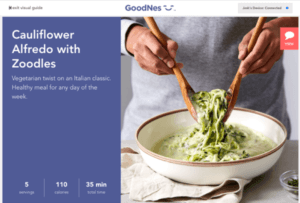Who Currently Uses It?
Companies are becoming increasingly invested in AI and chatbots as a result of voice assistance shifting from early adoption into mass adoption.
Think about it; today, the majority of online users are aware of virtual assistants such as Siri, Cortana & Alexa. A study conducted by Skims has found that almost half of the UK population is using voice assistants on their smartphones – with family households the most prominent users of voice technology.
How Do Users Interact With It?
Voice assistants help you save a lot of time when completing basic life admin activities such as ordering meals, shopping, booking appointments setting reminders, and simple product search queries.
Curiosity is the strongest drive in initial voice purchases, although a lack of accuracy and visual confirmation of product orders are the primary blockades against mass adoption. Despite this, Amazon is constantly trying to nudge behaviour by providing discounts for products purchased via voice assistants.
These technologies are bound to improve due to their innate nature based on machine learning. Let’s also not forget how many millions of dollars have been invested by the tech giants! Voice assistance is already too big to fail, and smarter AI will only allow the extraction of more usefulness. Last year, Google CEO, Sundar Pichai, presented the extraordinary abilities of Google Duplex. This updated assistant can make your appointments seamlessly in the background while you are busy with more important tasks. It recognises accents and can respond with a human attitude in unpredictable situations… you didn’t even imagine this in your wildest dreams, right?
How Can Marketer’s Use It to Their Advantage?
As a marketer, you need to prepare for the emergence of voice assistants by looking at your current marketing strategies and understanding how you can integrate voice assistance within your existing digital efforts. Voice assistants resemble a double-edged sword for most marketers. On the one hand, it can act as an enabler for greater brand loyalty. On the other hand, it can act as a threat to branding as a concept.
In a world where we shop via Alexa, Amazon gets to choose what to sell. So, the question is how you can reduce Amazon’s control and transform voice assistance into a branding tool?
With the emergence of voice assistants, both personalisation and relevance become even more important for marketers. Voice assistance allows direct connection with users, catching them at just the right moment (when they are purchasing). The validation process for split-testing and new product development will be based on highly accurate data derived directly from users.
Suddenly, understanding the customer is easier. Voice technology will dig deeper into users’ pains & motivations. The influx of data collected and analysed will be far larger than data currently collected on search and social channels.
Brands Using Voice Assistance as a Key Differentiator
These 3 examples demonstrate how voice assistants can be used as a powerful tool for standing out. Collaborations with Amazon & Google have been tested amongst brands.
KLM’s BlueBot – “Never Forget Anything Again With BlueBot”

KLM collaborated with Google Home to help make packing luggage easier for travellers with a smart packing assistant. BlueBot will ask you questions and help you pack for your trip as if it’s a friend that knows you and your holiday style well!
Nespresso’s Prodigio – “The Connected Nespresso Machine”- Alexa Integration

Nestlé – “Bring Voice Plus to the Kitchen”

Don’t know what to cook today? GoodNes provides visual and voice commands in collaboration with Alexa skills to help you cook the perfect meal for you and your loved ones.
Seems like the future has finally come and voice assistance is a vital part of it, creating a personality around technology as a whole. Until now, computers were just machines but now they can talk to you… who knew?!







